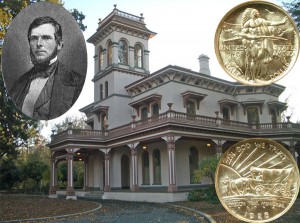Today, the Oregon Trail Commemorative Silver Half Dollar Coin remembers the first wagon train to arrive in California, though by the time it arrived the wagons were gone.
In May 1841, a group of 70 people, mostly men but with 15 women and children, met in Missouri to head west to California.
One of the party was John Bidwell. A young man in his early 20s, he later became known as the “Prince of California Pioneers.” Years later, he wrote several articles about the first wagon train and their journey to California.
As for the start of their journey, he wrote,
“We knew that California lay west, and that was the extent of our knowledge. Some of the maps consulted, supposed to be correct, showed a lake in the vicinity of where Salt Lake now is; it was represented as a long lake, three or four hundred miles in extent, narrow, and with two outlets, both running into the Pacific ocean, either apparently larger than the Mississippi River.”
Their party not only did not understand the challenges of the trail, but their group did not have confident leadership.
Regardless, the men and families banded together to head westward. Each person, or family, gathered their own clothing, supplies and tools for the journey.
Among the party, they could barely scrape together $100 – total – for any payments the group needed along the unknown route.
Once the trail entered Idaho, the group separated with some staying in the area, some working their way west via the Columbia River and some, roughly half, continuing the unknown path to California.
Both water and food became scarce as they struggled to find their way to California. The people abandoned their wagons and used their animals to carry their gear.
Unfortunately, neither the men nor the animals understood packing. The men did not know how to balance a pack or how to secure it. The animals had never carried packs before.
After lost animals and lost baggage, the group began to make progress again.
They knew they must get over the mountains before the winter prevented their travels.
Through luck and trial and error, the group traveled over the Sierras in late October.
John Bidwell described their group’s arrival on the western side of the mountains,
“When morning came the foremost of the party waited for the others to come up. They had found water in a stagnant pond, but what was better, they had shot a fat coyote and with us it was anything but mule meat. As for myself, I was unfortunate, being among those in the rear and not aware of the feast in the advance. I did not reach it in time to get any of the coyote except the lights and the windpipe. Longing for fat meat and willing to eat anything but poor mule meat and seeing a little fat on the windpipe of the coyote, I threw it on the coals to warm it and greedily devoured it.
“But halcyon days were at hand. We turned directly to the north to reach what seemed to be the nearest timber. This was at a distance of ten miles or so, which in our weakened condition it took us nearly all day to travel. It brought us to the Stanislaus River at a point not far from the foothills. Here the rich alluvial bottom was more than a mile wide. It had been burned over, but the new grass was starting up and growing luxuriously but sparsely, like thinly sown grain. But what gladdened our eyes most was the abundance of game in sight, principally antelope. Before dark we had killed two of them and two sand-hill cranes, and besides there was an abundance of ripe and luscious wild grapes. Still we had no idea that we were yet in California, but supposed we had yet to cross the range of mountains to the West.”
After six months on their westward journey, the rag-tag party arrived at the ranch of Dr. John Marsh on November 4, 1841 becoming the first “wagon train” to arrive in California.
The Oregon Trail Commemorative Silver Half Dollar Coin shows against a small portrait of John Bidwell along with a modern view of the Bidwell Mansion in Chico, California.
